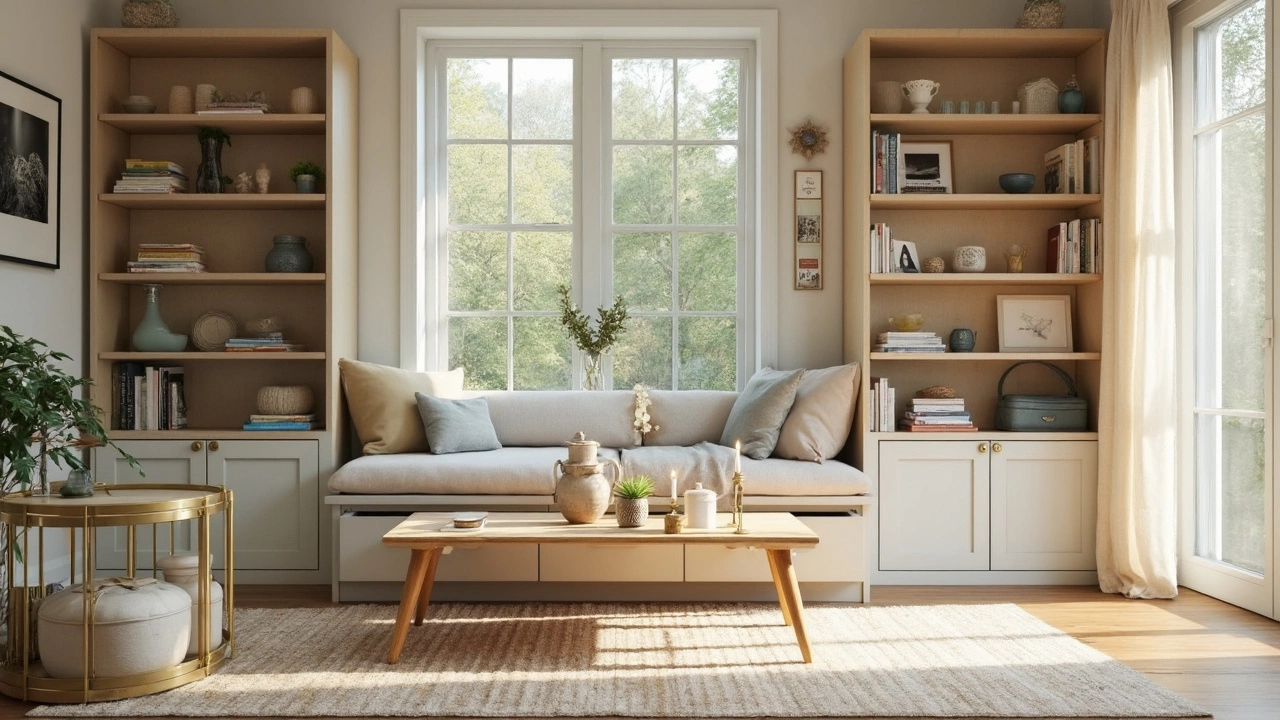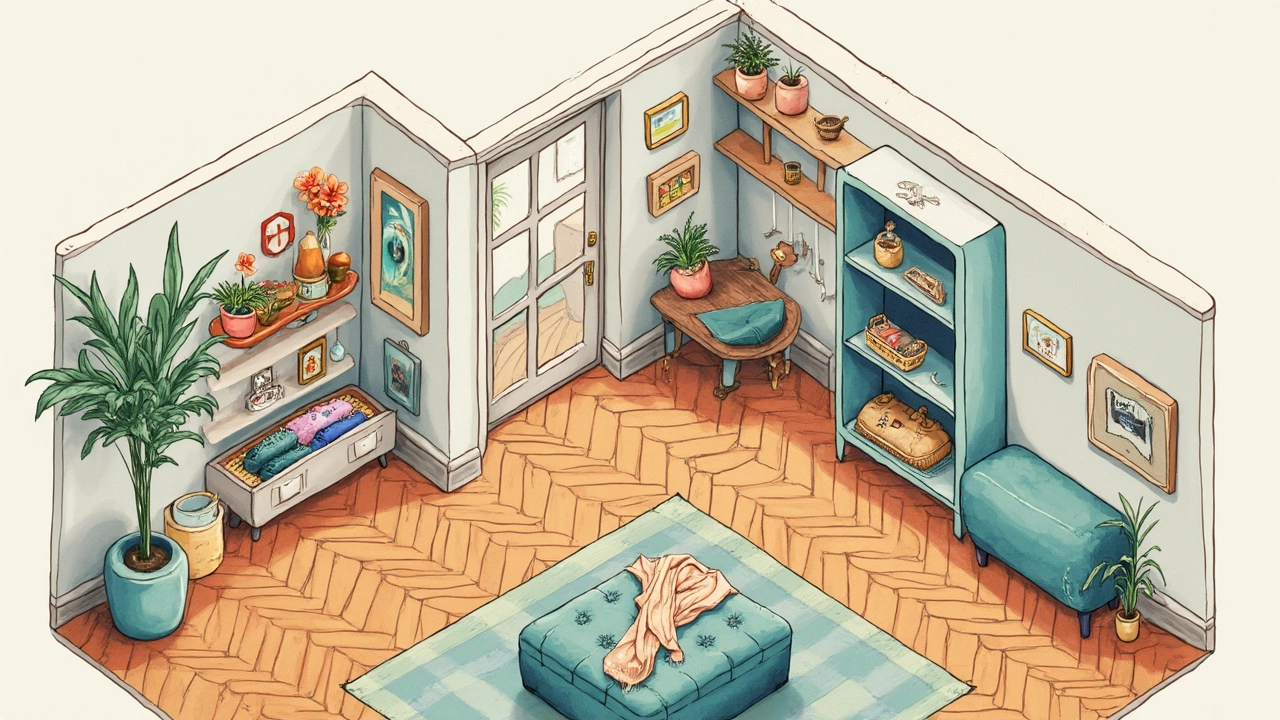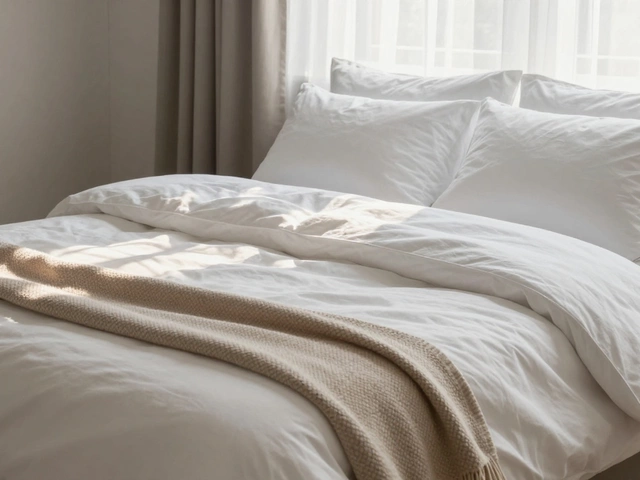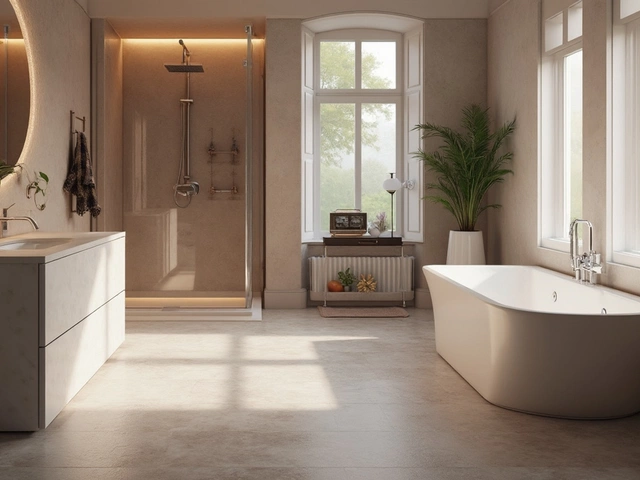Maximize Storage in a Small House: Simple, Smart Ideas That Work

Ever walk into your small house and just feel like your stuff is taking over? You're not alone. Most people actually waste a ton of vertical and hidden space at home, even though these are the spots that can make all the difference.
If you’re tired of tripping over shoes at the door or digging through wardrobes just to find your favorite t-shirt, then it’s time to look at your space in a new way. There are easy tricks—and you don’t need to buy fancy gear or spend days on a total overhaul. Something as simple as a wall-mounted shelf or a bed with built-in drawers can open up room you didn’t know you had.
Let’s get practical. Start by taking stock of what you actually use day to day. Be honest. The less you keep, the less you have to store. Then, focus on your furniture—if it’s not helping you stash something away, it’s not doing its job. Don’t forget about the back of your doors, the bit of space above the kitchen cabinets, or even the gap under your couch.
The best part? Once you get these systems in place, you’ll spend less time tidying up and more time enjoying your home, no matter the size.
- Get Ruthless: Decluttering with Purpose
- Furniture That Does Double Duty
- Go Vertical: Make the Most of Wall Space
- Hidden and Overlooked Storage Spots
- Daily Habits for Staying Organized
Get Ruthless: Decluttering with Purpose
Let’s face it—most of us keep a lot more than we need. In a small home, that’s a fast track to crowded shelves and overflowing closets. The trick? Get ruthless. If you haven’t used it in a year, you probably won’t miss it. Not sure where to start? Try emptying a whole section, like your wardrobe or kitchen drawer, and lay everything out so you can see what you’ve got.
Here’s a quick way to break down the decluttering process:
- Sort your items into three piles: Keep, Donate, Toss.
- Ask yourself, “Do I love this? Do I use this regularly?” If not, it moves to Donate or Toss.
- Double check duplicates. Do you really need three spatulas or five black t-shirts?
- Set a realistic limit for each category (like only keeping enough mugs for the number of people in your house, plus a couple extras).
- Take action right after sorting—get those donation bags out of the house the same day.
Data from the National Soap and Detergent Association (yes, it’s real!) shows that eliminating clutter can reduce housework by 40%. That’s a serious time saver for any small space. Still feeling stuck? Challenge yourself with a simple rule: for every new thing you bring in, one old thing has to go.
| Clutter Type | Percent of People Who Keep Unused Items |
|---|---|
| Old Clothes | 68% |
| Books and Magazines | 52% |
| Kitchen Gadgets | 41% |
Once you’ve got your forgotten things gone, it’s way easier to focus on small house storage hacks that actually work. Just remember: when in doubt, keep only what actually earns its spot in your space. Less clutter means more room to live, move, and relax.
Furniture That Does Double Duty
If you want to maximize storage in a small house, single-purpose furniture just won't cut it. The real game-changer is picking out pieces that pull double duty—think beds, couches, benches, and tables with built-in storage, or items that fold away when you don't need them. This way, you get comfort and lots of extra space to stash your stuff.
One of the most popular options is the storage ottoman. You can sit on it, use it as a coffee table, and hide anything from blankets to board games inside. Then there’s the sofa bed—perfect for overnight guests without needing a spare room. Beds with built-in drawers won’t just look good, they keep your clothes, shoes, and extra bedding out of sight.
- Lift-top coffee tables are great for hiding remotes, magazines, or kids’ toys. Just lift the top and you’ll find a decent amount of space to work with.
- Bench seating that opens up can hold anything you don’t want cluttering your hallway or dining area.
- Drop-leaf dining tables or wall-mounted desks fold away when not in use, freeing up precious floor space.
If you’re into numbers, a 2024 IKEA survey found that nearly 70% of small-space dwellers said multi-functional furniture helped them use their homes better. That’s a lot of happy, organized people who aren’t just dreaming about decluttering—they're actually doing it.
| Furniture | Main Use | Storage Purpose |
|---|---|---|
| Storage Ottoman | Seat/Table | Blankets, toys, books |
| Bed with Drawers | Sleeping | Clothes, linens, shoes |
| Lift-top Coffee Table | Table | Magazines, remotes |
| Bench with Storage | Seating | Shoes, bags, seasonal items |
Tip: Before you buy a new piece of furniture, ask yourself—can it give me storage, too? There are even couches out there with hidden compartments or side pockets built into the armrest. So get creative. Every item that earns a place in your small house should earn its keep by making life a little more organized.

Go Vertical: Make the Most of Wall Space
If floor space is tight, look up. Most people only use about half of their wall space, and that’s a ton of room waiting to work for you. When you start using your walls for storage, things get off the floor and clutter drops fast.
Wall-mounted shelves are a game changer in small homes. According to a 2022 survey by the National Association of Home Builders, built-in shelving can boost storage space by nearly 30% in rooms under 200 square feet. Grab adjustable shelves so you can move them around as your stuff changes. Open shelving in kitchens or living rooms lets you see what you own, which helps you avoid buying the same things twice.
Don’t just stop at shelves. Hooks, pegboards, and magnetic strips can all help corral the chaos:
- Use sturdy hooks behind doors for bags, hats, or keys.
- Hang a pegboard in the kitchen or craft nook for utensils or supplies.
- Try magnetic strips in the bathroom for grooming tools or in the kitchen for knives.
If you’ve never heard of vertical cabinets, you’re missing out. These slim, tall units tuck right into corners and awkward nooks, making them great for places like bathrooms or hallways where every inch counts.
Check out this handy comparison table to weigh your options:
| Solution | Best For | Est. Added Storage | Typical Cost |
|---|---|---|---|
| Wall Shelves | Living rooms, kitchens, bedrooms | Up to 25 sq. ft. per room | $30–$100 per set |
| Pegboards | Workspaces, kitchens, entryways | Up to 10 sq. ft. | $15–$50 |
| Hooks/Racks | Behind doors, bathrooms, closets | Up to 8 items per rack | $10–$40 |
| Vertical Cabinets | Bathrooms, corners, laundry rooms | Varies (slim/tall design) | $50–$200 |
The best rule? Keep the stuff you use most where you can reach it, and put special-occasion or bulky items up high. Using small house storage tricks, like stacking and hanging, can double the space you thought you had. It’s all about making those walls work harder for you, not the other way around.
Hidden and Overlooked Storage Spots
If you think you’ve maxed out all your storage space, there’s a good chance you’re missing some pretty decent gaps. Most small houses have corners, nooks, and crannies that never get used for anything. Yet these overlooked spots can be storage goldmines with some quick fixes.
For example, the space under your stairs isn’t just for hiding dust bunnies. Adding custom pull-out drawers or even a sliding cupboard turns it into a serious organizer for shoes, bags, or sports gear. The inside of cabinet doors is another smart place. Stick on slim racks or hooks for things like cutting boards, cleaning bottles, and even measuring cups.
Don’t ignore vertical areas, either. The space above door frames can hold a thin shelf for small books, photo albums, or baskets full of random odds and ends. Experts say that using these hidden spots can increase your usable storage by up to 15%—that’s a chunk of room in a little house! In a study by the National Association of Home Builders, 57% of homeowners wished they had better storage solutions, and most admitted they forget about the backs of closets and doors entirely.
"Look for possibilities in places you normally ignore: tops of cabinets, corners under the sink, or even the wall space behind your bed can hold a shelf or basket." — Marie Kondo, organizing consultant
Here’s a helpful checklist of genuinely hidden storage areas you might not have tapped into yet:
- Behind and above closet doors (over-the-door racks are lifesavers)
- Inside deep drawers with stackable boxes or drawer dividers
- Under beds—plastic bins or rolling drawers work wonders
- Above kitchen cabinets for not-often-used cookware
- Bathroom wall shelves above the toilet
- Corner shelves in tight or awkward spaces
- Footstools or ottomans with built-in compartments
Sometimes, adding just a couple of small tweaks to these spots can make your home feel a lot less cramped. And if you’re worried about things looking messy, clear bins or labeled baskets keep everything tidy without turning your home into a storage unit.
| Hidden Spot | Average Storage Capacity |
|---|---|
| Under-bed bins | 3-4 cubic feet |
| Above door shelves | 1-2 cubic feet |
| Behind cabinet doors | <1 cubic foot |
| Under stairs (drawers/cabinets) | 5-12 cubic feet |
No house is too small for smart storage. Once you start using these small house storage ideas, you might be surprised at how much easier it gets to stay organized and clear out everyday clutter.

Daily Habits for Staying Organized
Keeping a small house neat isn’t just about where you put stuff—it’s about what you do every day. Even the best small house storage hacks can’t save you from clutter if things pile up again. That’s why it helps to have a few easy, repeatable habits to stop mess before it starts.
Start with a quick “reset” every night. Just ten minutes spent putting things back in their spots can make your mornings smoother and keep piles from taking over. People who reset daily are 65% less likely to report overwhelming mess, according to a May 2024 survey by Tiny Living Research.
- Put away shoes, bags, and jackets as soon as you get home—not later.
- Tidy up kitchen counters right after making a meal; don’t let dishes or junk mail linger.
- Teach kids (or roommates) to return toys, books, or gadgets to their “home” right after using them—it saves time cleaning up later.
- Do a weekly sweep and pick one small area to declutter—maybe the junk drawer or bathroom shelf.
If you’re sharing your small space, get everyone involved with a simple rule: if you get it out, you put it back. It’s surprisingly effective, no bossy checklists needed.
Remember the "one in, one out" trick. Buy a new shirt? Donate an old one. Bring in a new mug? Out goes one you never use. It sounds simple (and it is), but it really keeps your storage from getting overwhelmed.
Here’s a snapshot of how little daily moves keep clutter at bay over time:
| Habit | Average Time/Day | Space Saved per Year* |
|---|---|---|
| Nightly Reset | 10 minutes | Over 4 square feet (from not letting piles grow) |
| Weekly Declutter | 15 minutes | One full cabinet or drawer (as old items go out) |
| One In, One Out Rule | No extra time | Up to 50 items/year |
*Source: Tiny Living Research 2024, based on average two-person households in homes under 800 sq ft
The goal isn’t a magazine-perfect house. It’s a space you can live in, find things fast, and not stress about company dropping by. Just a couple minutes a day honestly adds up, freeing up your brain (and your floor) for stuff you actually care about.





